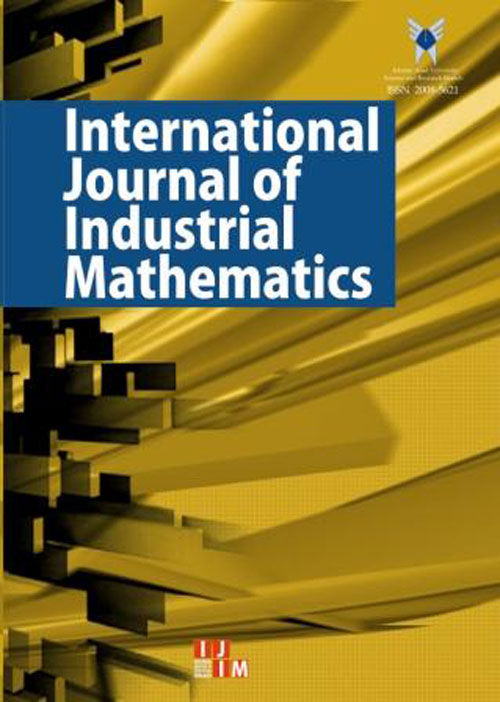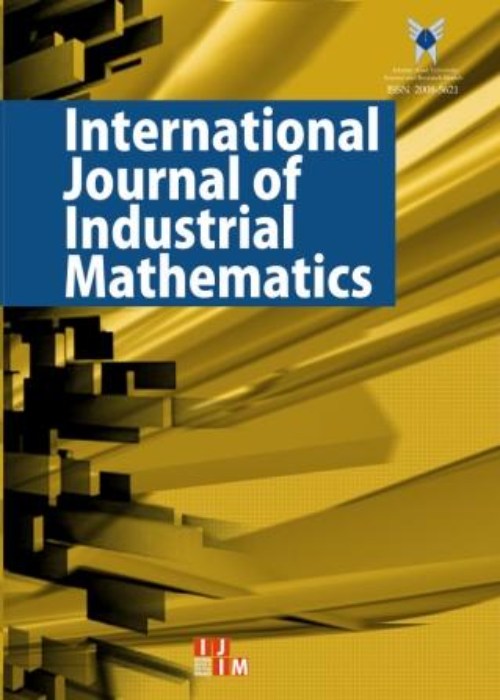فهرست مطالب

International Journal of Industrial Mathematics
Volume:10 Issue: 1, Winter 2018
- تاریخ انتشار: 1397/01/20
- تعداد عناوین: 11
-
-
Pages 1-8ýThe main purpose of this paper is to analyze the exchange rate volatility in Iran in the time period between 2011/11/27 and 2017/02/25 on a daily basis. As a tradable asset and as an important and effective economic variable, exchange rate plays a decisive role in the economy of a country. In a successful economic management, the modeling and prediction of the exchange rate volatility is essential for economic policies. Therefore, modeling and forecasting the changes in exchange rates for economic policies is vital. Foreign currency has the particular property of stochastic volatility, which can be modeled as a stochastic differential equation. In order to provide the best model, first, we studied the effectiveness of different stochastic models, drew upon the daily price of the exchange rate, and investigated the performance of these models. Finally, the best model was achieved by taking into account the numerical simulation and the mean square error, Akaikes (AIC), Schwarzâs Bayesian (SBIC), and the Hannan-Quinn (HQIC) ýcriteria.Keywords: Stochastic differential equation, Geometric Brownian motion, Volatility of exchange rate, White ýnoise
-
Pages 9-18The paper presents analysis of two-dimensional non-Newtonian incompressible viscous flow between parallel plates. The governing problem of momentum equations are reduced to nonlinear ordinary differential equation (NODE) using similarity transformations. The resulting equation is solved using computer extended series solution (CESS) and homotopy analysis method (HAM). These methods have advantages over pure numerical methods for obtaining the derived quantities accurately for various values of parameters and results are valid in much larger parameter domain compared with numerical schemes.ýKeywords: Squeezing flow, CESS, HAM, Casson fluid, Pade approximants
-
Pages 19-27In this paper, we present a new computational method to solve Volterra integral equations of the first kind based on Bernstein polynomials. In this method, using operational matrices turn the integral equation into a system of equations. The computed operational matrices are exact and new. The comparisons show this method is acceptable. Moreover, the stability of the proposed method is studied.Keywords: Volterra integral equation, Bernstein polynomials, Operational matrices, Transformation matrices
-
Pages 29-37This article proposes a fast and accurate expansion-iterative method for solving second kind linear Volterra integral equations. The method is based on a special representation of vector forms of triangular functions (TFs) and their operational matrix of integration. By using this approach, solving the integral equation reduces to solve a recurrence relation. The approximate solution of integral equation is iteratively produced via the recurrence relation.Keywords: Second kind Volterra integral equation, Triangular functions, Recurrence relation, Operational matrix, Iterative method
-
Pages 39-45This paper proposes an immediately efficient method, based on Benders Decomposition (BD), for solving the survivable capacitated network design problem. This problem involves selecting a set of arcs for building a survivable network at a minimum cost and within a satisfied flow. The system is subject to failure and capacity restriction. To solve this problem, the BD was initially proposed with far outperformed than mixed integer programming. The employed method in this paper is the modified BD i.e. it identifies the initial failure scenario which are to be solved by BD, proposing a new strategy on the basis of s-t cut theorem. For a comparison between the BD method and our modified BD method, four network sets including one origin, one destination, four failure scenario, one supply node and one demand node have been randomly produced. Next, by using GAMS software, the two methods are compared with respect to their required CPU time where it is shown that the proposed method vitally saves time as much as 30%. This strategy reduces iterations more greatly as compared with the BD approach. While other methods concentrate on valid inequalities for reducing iterations of BD, this study does not use such valid inequalities. In addition, the new method is easily and quickly implementable.Keywords: Survivable, Network Design, Benders Decomposition, failure scenario
-
Pages 47-51ýIn this paper we take $\mathcal A$ to be the category {\bf Pos-S}ý ýof $S$-posetsý, ýfor a posemigroup $S$ý, ${\mathcal M}_{pd}$ toý ýbe the class of partially ordered sequantially-denseý ýmonomorphisms and study the categorical propertiesý, ýsuch asý ýlimits and colimitsý, ýof this classý. ýThese properties are usuallyý ýneeded to study the homological notionsý, ýsuch as injectivityý, ýofý ý$S$-posetsý.Keywords: Po, S, Dense?, ??$?S$, Poset?, ?Limit?, ?Colimit
-
Pages 53-71Burgers equation is a simplified form of the Navier-Stokes equation that represents the non-linear features of it. In this paper, the transient two-dimensional non-linear Burgers equation is solved using the Lattice Boltzmann Method (LBM). The results are compared with the Modified Local Crank-Nicolson method (MLCN) and exact solutions. The LBM has been emerged as a new numerical method for solving various physical problems.Keywords: Non, linear Burgers equation, Adomian method, the modified Local Crank, Nicolson method
-
Pages 73-82In the conventional data envelopment analysis (DEA), it is assumed that all decision making units (DMUs) using the same input and output measures, means that DMUs are homogeneous. In some settings, however, this usual assumption of DEA might be violated. A related problem is the problem of \textit{missing} \textit{data} where a DMU produces a certain output or consumes a certain input but the values are not available. To address this problem there are some approaches which assign a value (e.g. zero or average of existing values) to the missing data. On the other hand, there are situations where the missing output or input can be produced or consumed by the DMU but for some reasons, an output is not created or the DMU does not have accessibility to an input, hence assigning an artificial value to the nonexistent factor is inappropriate. As some recent studies have focused on addressing the problem of nonhomogeneity among inputs and outputs measures, it has become increasingly important to undrestand its cost structure. This study develops a new DEA methodology to assess cost efficiency (CE) of DMUs in the situation of nonhomogeneous DMUs with different outputs configurations. Via proceeding in three-step procedure both CE scores and subgroup CE scores of DMUs is derived. A numerical example containing a set of 47 steel fabrication plants is used to show the applicability of the model.Keywords: Cost efficiency, Data Envelopment Analysis, Nonhomogeneous ?DMUs, (Mono)?m?orphism
-
Pages 83-90In this paper a new method for solving fuzzy differential equation with fractional order is considered. The fuzzy solution is construct by power series in the Caputo derivatives sense. To illustrate the reliability of method some examples are provided. In this paper a new method for solving fuzzy differential equation with fractional order is considered. The fuzzy solution is construct by power series in the Caputo derivatives sense.Keywords: Generalized Hukuhara differentiability, Caputo differentiability, Fuzzy fractional differential equations
-
Pages 91-98In this study, a numerical solution of singular nonlinear differential equations, stemming from biology and physiology problems, is proposed. The methodology is based on the shifted Chebyshev polynomials operational matrix of derivative and collocation. To assess the accuracy of the method, five numerical problems, such as the human head, Oxygen diffusion and Bessel differential equation, were solved. The numerical results were compared with other existed methods in tables for verification.Keywords: Differential equations?, ?Shifted Chebyshev polynomials?, ?Operational matrix of derivative?, ?Convergence analysis?, ?Physiology problems?
-
Pages 99-110The correlated models are introduced in this article regarding revenue efficiency and profit efficiency in dynamic network production systems. The proposed models are not only applicable in measuring efficiency of divisional, periodical and overall efficiencies, but recognizing the exact sources of inefficiency with respect to revenue and profit efficiencies. Two numerical examples, consisting of twoperiods and , are presented to illustrate these proposed models.Keywords: DEA, Network, structures, revenue efficiency, profit efficiency


